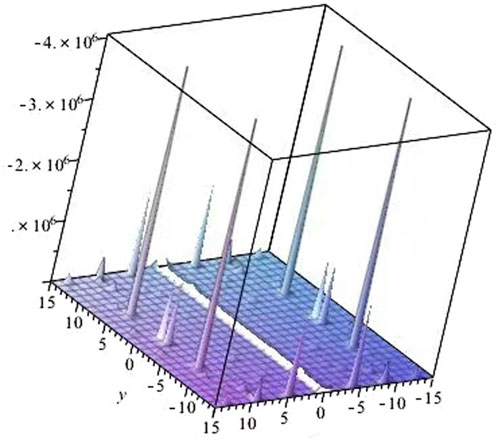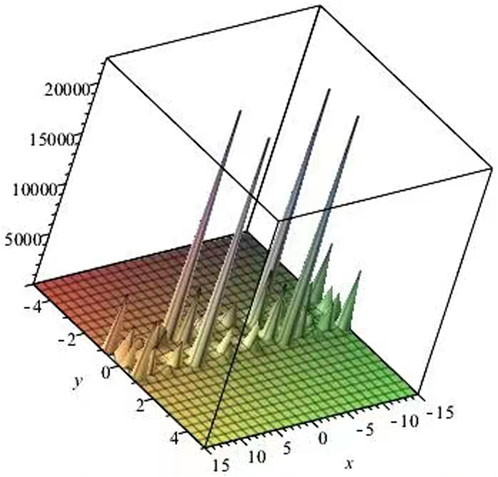- 1Scientific Research Department, Party School of CPC Fushun, Fushun, China
- 2Institute of Data Science and Engineering, Xuzhou University of Technology, Xuzhou, China
The nonlinear partial differential equations are not only used in many physical models, but also fundamentally applied in the field of nonlinear science. In order to solve certain nonlinear partial differential equation, the extended hyperbolic auxiliary equation method (EHAEM) is introduced in this article by means of the symbolic computation software. The basic idea of the new algorithm is that if certain nonlinear partial differential equation can be converted into the form of elliptic equation, then its solutions are readily obtained. By taking the generalized Schr
1 Introduction
Many phenomena in physics and the other disciplines are frequently characterized by nonlinear partial differential equations (PDEs) [1]. To comprehend the physical mechanisms underlying natural phenomena described by these nonlinear PDEs, it is essential to investigate exact solutions for such equations. The exploration of exact solutions to nonlinear PDEs has emerged as a significant aspect of research into nonlinear physical phenomena [2].
Due to the inherent complexity of nonlinear partial differential equations (PDEs), there is no universal method available for finding solutions to all PDEs. Significant progress has been made in the calculation of exact solutions to partial differential equations (PDEs),with the establishment of numerous important methodologies. Some typical methods include inverse scattering transform method [3], Darboux transform [4], B
Motivated by the above-analysis, we provide explicit solutions to the subsidiary elliptic-like equation through the application of symbolic computation software (MAPLE), utilizing both the power-exponential function method (PFM) and the extended hyperbolic auxiliary equation method (EHAEM). Then the exact solutions to a Category of nonlinear PDEs are derived. A new algebraic method for solving the nonlinear PDEs is proposed, which is called the AEM. By applying this method to the generalized Schr
2 Introduction of the extended hyperbolic AEM
Step 1 For a given nonlinear PDE with one physical field
We assume that the form of its travelling wave solution is
Step 2 In order to find the travelling wave solutions of Equation 2, we assume that the form of the solutions can be expressed as the following Equation 3
where
By balancing the highest degree linear term and nonlinear term in (2), the degree n can be determined.
Step 3 Substituting (3) and (4) into (2) and setting the coefficients of
Step 4 With the help of symbolic computation software Mathematica to solve the series of algebraic equations, we can obtain the exact expressions of
Step 5 When the values of
Case 1 When
Case 2 When
Case 3 When
Case 4 When
Case 5 When
Case 6 When
Case 7 When
Case 8 When
Case 9 When
Case 10 When
Case 11 When
Case 12 When
Case 13 When
Case 14 When
3 Solutions of the elliptic-like equation
where
3.1 Application of the power-exponential function method
Supposing the solution of Equation 19 is
where
Substituting (Equation 20) into (Equation 19) and setting the coefficients of all powers of
Taking advantage of Mathematica, yield
We can derive many kinds of solutions of Equation 19 by substituting Equation 22 into Equation 20.
Family 1 For
where
Family 2 For
Family 3 For
3.2 Application of the extended hyperbolic AEM
In light of the need for a coherent and balanced relationship between the two components
where
Combing Equations 4, 19, 26 and collecting the coefficients of
Solving the algebraic (Equation 27) by software Maple, one can derive the following results.
Family 1
where
Family 2
Combining Equations 5–18, and substitute Equations 28, 29, 30, or 31 into Equation 26, we can derive various solutions of Equation 19.
(i) Jacobi-type solutions
where
where
where
where
where
where
where
(ii) Bell profile solitary wave solution
where
(iii) Singular soliton solution
with
(v) Dark soliton wave solution
4 Applications to the generalized Schrödinger equation
The generalized Schr
Equation 47, which can describe practical phenomenon, can be divided into a series of integrable models [17, 18]. Using the previously-provided method, we can get solutions of Equation 47.
By putting the following Equation 48
into Equation 47, we have
we need to determine
Equation 49 coincides with Equation 19, where
The constraint conditions are expressed as the following Equation 50
Then the solutions of Equation 47 are
Combing Equations 23–25, 33–46, 51, we can derive solutions of the generalized Schr
where
where
where
where
where
where
where
where
where
Remark The proposed method can also be extended to the other type of nonlinear partial differential equations. Figures 1, 2 provide the solitary wave solutions of Equation 47.

Figure 1. Solitary wave solution u10 of Equation 47, with the integration constant be one, and m 1/2 at times t = 3.14.

Figure 2. Solitary wave solution u15 of Equation 47, with the integration constant be one, and m = 1/2 at times t = 3.14.
5 Conclusion
In summary, the AEM is presented and applied to the generalized Schr
In addition, Fan and Chow [19] once applied the Bell polynomials to deduce the Darboux covariant Lax pairs and infinite conservation laws of some (2 + 1)-dimensional nonlinear evolution equations. Based on this theory, we hope investigate some corresponding properties of Equation 47 presented in the paper in future. Application of the current method to the fractional nonlinear partial differential equations is another future direction [20].
Data availability statement
The original contributions presented in the study are included in the article/supplementary material, further inquiries can be directed to the corresponding author.
Author contributions
BL: Data curation, Formal Analysis, Funding acquisition, Methodology, Resources, Software, Validation, Visualization, Writing–original draft, Writing–review and editing. FW: Conceptualization, Investigation, Supervision, Writing–original draft, Writing–review and editing.
Funding
The author(s) declare that financial support was received for the research, authorship, and/or publication of this article. The work was supported by the University Natural Science Research Project of Anhui Province (Project No. 2023AH050314) and the Horizontal Scientific Research Funds in Huaibei Normal University (No. 2024340603000006).
Conflict of interest
The authors declare that the research was conducted in the absence of any commercial or financial relationships that could be construed as a potential conflict of interest.
Generative AI statement
The author(s) declare that no Generative AI was used in the creation of this manuscript.
Publisher’s note
All claims expressed in this article are solely those of the authors and do not necessarily represent those of their affiliated organizations, or those of the publisher, the editors and the reviewers. Any product that may be evaluated in this article, or claim that may be made by its manufacturer, is not guaranteed or endorsed by the publisher.
References
1. Adeyemo O, Khalique C, Gasimov Y, Villecco F. Variational and non-variational approaches with Lie algebra of a generalized (3+1)-dimensional nonlinear potential Yu-Toda-Sasa-Fukuyama equation in Engineering and Physics. Alex Eng J (2023) 63:17–43. doi:10.1016/j.aej.2022.07.024
2. Khalique C, Adeyemo O, Monashane M. Exact solutions, wave dynamics and conservation laws of a generalized geophysical korteweg De vries equation in ocean physics using lie ssmmetry analysis. Adv Math Models Appl (2024) 9:147–72. doi:10.62476/amma9147
3. Ablowitz M, Clarkson P. Solitons, nonlinear evolution equations and inverse scattering. Cam-Bridge. Cambridge University Press (1991).
4. Lamb GL. Analytical descriptions of ultrashort optical pulse propagation in a resonant medium. Rev Mod Phys (1971) 43:99–124. doi:10.1103/RevModPhys.43.99
5. Zhang YF, Wang Y. A new reduction of the self-dual YangCMills equations and its applications. Z Naturforsch A (2016) 71:631–8. doi:10.1515/zna-2016-0138
6. Zhang YF, Bai Y, Wu L. Upon generating (2+1)-dimensional dynamical systems. Int J Theor Phys (2016) 55:2837–56. doi:10.1007/s10773-016-2916-z
7. Zhang YF, Rui WJ. A few continuous and discrete dynamical systems. Rep Math Phys (2016) 78(1):19–32. doi:10.1016/S0034-4877(16)30047-7
8. Fan EG. Extended tanh-function method and its applications to nonlinear equations. Phys Lett A (2000) 277:212–8. doi:10.1016/S0375-9601(00)00725-8
9. Li BC, Zhang YF. Explicit and exact travelling wave solutions for Konopelchenko-Dubrovsky equation. Chaos Soliton Fractal (2008) 38:1202–8. doi:10.1016/j.chaos.2007.01.059
10. Dilara K, Gasimov Y, Bulut H. A sstudy on the investigation of the travelling wave solutions of the mathematical models in physics via (m + (1=g0))-expansion method. Adv Math Models Appl (2024) 9:5–13. doi:10.62476/amma9105
11. Rabie WB, Ahmed HM, Nofal TA, Mohamed EM. Novel analytical superposed nonlinear wave structures for the eighth-order (3+1)-dimensional Kac-Wakimoto equation using improved modified extended tanh function method. AIMS Math (2024) 9:33386–400. doi:10.3934/math.20241593
12. Li BC. New exact solutions to a category of variable-coefficient PDEs and computerized mechanization. Chin J Eng Math (2016) 33:298–308. doi:10.3969/j.issn.1005-3085.2016.03.008
13. Sirendaoreji . A new auxiliary equation and exact travelling wave solutions of nonlinear equations. Phys Lett A, 356 (2006), 124–30. doi:10.1016/j.physleta.2006.03.034
14. Gabriel D, Fabien N, Saidou A, Alidou M. Rogue waves dynamics of cubic-quintic nonlinear Schrodinger dinger equation with an external linear potential through a modified Noguchi electrical transmission network. Commun Nonlinear Sci (2023) 126:107479. doi:10.1016/j.cnsns.2023.107479
15. Fan LL, Bao T. Weierstrass elliptic function solutions and degenerate solutions of a variable coefficient higher-order Schrödinger equation. Phys Scripta (2023) 98:095238. doi:10.1088/1402-4896/acec1a
16. Jamilu S, Mayssam TS, Ali T, Hadi R, Mustafa I, Ali A. New exact solitary wave solutions of the generalized (3+1)-dimensional nonlinear wave equation in liquid with gas bubbles via extended auxiliary equation method. Opt Quant Electron (2023) 55:586. doi:10.1007/s11082-023-04870-1
17. Wang FZ, Salama SA, Khater MA. Optical wave solutions of perturbed time-fractional nonlinear Schrodinger dinger equation. J Ocean Eng Sci Doi. doi:10.1016/j.joes.2022.03.014
18. Zhang J, Wang FZ, Khater MA. Stable abundant computational solitary wave structures of the perturbed time-fractional NLS equation. J Ocean Eng Sci (2022). doi:10.1016/j.joes.2022.05.012
19. Fan EG, Chow KW. Darboux covariant Lax pairs and infinite conservation laws of the (2+1)-dimensional breaking soliton equation. J Math Phys (2011) 52:1–10. doi:10.1063/1.3545804
Keywords: partial differential equation, solitary wave solution, Jacobian elliptic function solution, symbolic computation software, computerized mechanization
Citation: Li B and Wang F (2025) New solutions to a category of nonlinear PDEs. Front. Phys. 13:1547245. doi: 10.3389/fphy.2025.1547245
Received: 18 December 2024; Accepted: 09 January 2025;
Published: 30 January 2025.
Edited by:
Muktish Acharyya, Presidency University, IndiaReviewed by:
Yusif Gasimov, Azerbaijan University, AzerbaijanGour Bhattacharya, Presidency University, India
Copyright © 2025 Li and Wang. This is an open-access article distributed under the terms of the Creative Commons Attribution License (CC BY). The use, distribution or reproduction in other forums is permitted, provided the original author(s) and the copyright owner(s) are credited and that the original publication in this journal is cited, in accordance with accepted academic practice. No use, distribution or reproduction is permitted which does not comply with these terms.
*Correspondence: Fuzhang Wang, d2FuZ2Z1emhhbmcxOTg0QDE2My5jb20=
 Bacui Li1
Bacui Li1 Fuzhang Wang
Fuzhang Wang